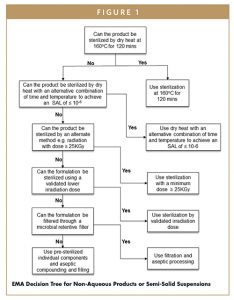Issue:June 2019
PARENTERAL DEVELOPMENT - Considerations in Developing Complex Parenteral Formulations
INTRODUCTION
Parenteral formulations are broadly characterized as sterile solutions, suspensions, emulsions, and powders for reconstitution for injection or infusion; they are administered directly to subjects, entering the systemic circulation and typically providing rapid onset of action in comparison to orally administered products. Small-volume parenteral products are generally presented in vials or ready-to-use pre-filled syringes, providing ease-of-use in the clinical setting or for patient self-administration. The path to delivering these stable, apparently simple solution, suspension, or emulsion formulations is multi-faceted and requires a constant focus on key control measures through pre-formulation development to commercialization.
Formulation scientists, analytical chemists, process operations staff, and engineers collaborate with microbiologists, quality assurance colleagues, regulatory specialists, and clinicians to ensure each product meets target attributes for safe administration to patients. For a given product, target attributes are described in the product specification and for all parenteral products, this includes an absolute requirement to be sterile and pyrogen controlled. The management of input materials, fluid pathway, and the specific product formulation process all must be controlled to ensure these key attributes.
DEFINING COMPLEXITY
As the sterile injectable market continues to see rapid growth (~10% to 15% per annum) – outpacing growth of oral products – it is natural to see the diversity of parenteral product formulations increasing in parallel. Simple, stable aqueous solutions manufactured via aseptic filtration and filling or terminal sterilization remain the target of any sterile injectable development and many small molecule products continue to employ traditional solubilization techniques, including ionization (pH) adjustment and the use of cosolvents, surfactants, or complexing agents, such as cyclodextrins.
The definition of complexity in parenteral formulation development is broad; it varies based on the stage of development and the specific nature of the challenge. A notionally simple, stable reproducible laboratory formulation may carry a level of complexity in aseptic control if routine means of sterilization are unavailable.
Lyophilization, whilst a commonplace means to stabilize products (small molecules through peptides, proteins, antibodies, antibody drug conjugates), requires skilled formulators and a clear understanding of variables impacting scale-up to ensure smooth, ensured transition through clinical phase, scale-up, and commercialization. If the product can be manufactured using an embedded, qualified aseptic filtration process or can be supported better by terminal sterilization, the level of complexity is reduced for the aseptic manufacturing team.
However, a scenario with a lyophilized PLGA-loaded suspension product that cannot be supported by aseptic filtration nor terminal sterilization can bring challenges to all teams involved in the product development. For the formulation scientist, drug loading, particle size control, ease/reliability of suspension, agglomeration, fill accuracy, and content uniformity all bring a level of challenge. For the aseptic manufacturing team, the challenge (and thus the complexity) is additive; a specific aseptic process would need to be designed and likely requires specific media fill qualification to ensure process robustness.
PROCESS TECHNOLOGIES SUPPORTING COMPLEX PRODUCT GROWTH
A focus on the patient who will undoubtedly benefit through administration of a controlled, targeted-release product with reduced systemic exposure must be maintained. This remains a strong driver for processes to adapt to emerging technologies and critical clinical applications. Historically, cytotoxic or potent compounds may have been developed as “simple” formulations, offering little discrimination in the targeting of delivered dose to intended site of action. New formulation capabilities and/or delivery technologies are supporting the repurposing of established agents as targeted therapies or enabling the development of new, potent, chemical entity products as more focused products, maximizing efficacy whilst minimizing systemic risk.
An increased requirement to handle potent active substances has been an ongoing trend, and suitable containment requirements for these compounds, particularly in multi-product facilities, has been a focus for pharma companies and CDMOs alike. This focus has been matched by the growth of single-use technologies that seek to minimize risk of product cross contamination in multi-use facilities.
Single-use technologies also allow a modular approach in which complex fluid pathways can be designed as closed systems with sterile connectors. The ability to design a bespoke irradiated fluid pathway that can be assembled in a cleanroom greatly assists the transition of complex processes from laboratory to cleanroom. Increased automation removes operators from the aseptic core and barrier systems, which effectively remove the operator from the aseptic process and is highly advantageous in reducing risk in the cGMP manufacture of complex formulations.
Differentiated filling technologies within Restricted Access Barrier Systems (RABS) or isolators may be necessary to support a broad range of formulation possibilities. Peristaltic pump processes are well suited to biologics, such as proteins and antibodies, in which sensitivity to shear is a concern. Peristaltic processes easily align with single-use technologies and rapid turnaround, reducing the requirement for product-specific cleaning and in turn allowing greater utilization of cleanroom facilities. Highly viscous formulations (potentially based on high drug load in solvent/cosolvent formulations) may require a pressurized filtration process and a rotary piston pump to ensure accuracy of fill. This system is ideal for a dedicated process but less flexible in multi-product facilities and typically requires product-specific cleaning to minimize product carry over concerns.
Complexity broadly aligns as a descriptor in which the challenge is presented as drug substance with limited/poor solubility; this also necessitates alternative approaches for development. As a result, the requirement to evaluate alternative presentations, such as suspensions, emulsions, solvent based, or incorporating novel excipients, is also on the rise. About 40% of drugs with market approval and nearly 90% of molecules in the discovery pipeline are poorly water-soluble.1
ASEPTIC CHALLENGE
Complex formulation or drug product challenges are classically considered to pertain to the attainment of a target physicochemical characteristic, eg, active concentration/drug loading or particle size distribution. Whilst these remain an initial hurdle to overcome, appropriate solutions must also represent viable options for ultimate scale-up and cGMP manufacture. The complex formulation challenge can often represent the ability to define a robust process that facilitates drug product manufacture to target specification, whilst maintaining a practical aseptic process ensuring sterility assurance.
Like “simple” formulations, complex formulations must be formulated to be safe, stable, and effective in the target patient population. They must align with regulatory expectations and be manufactured under strict aseptic control.
Decision trees for the selection of sterilization methods (CPMP/QWP/054/98) apply to suspension, liposomal, and emulsion formulations and aqueous presentations alike. A decision tree for non-aqueous and suspensions is presented in Figure 1.
Often, by necessity, the controls ensuring sterility of complex parenteral formulations lie close to the base of the decision tree. Design of the aseptic process and most critically, aseptic qualification of the manufacturing team, are of equal importance to the skill of the formulation scientist developing the robust complex formulation. Success is delivered through knowledge transfer and a shared understanding of the broad complexity of the entire process. Teamwork is the foundation for success in delivering complex parenteral products to patients.
ASEPTIC PROCESS DEVELOPMENT
An armory of techniques supporting pre-formulation and formulation development should be utilized at the appropriate phase of product development. Bench-suitable screening tools used at the early, quick assessment stage should be replaced with scalable technologies as lead candidates emerge. A solid appreciation of aseptic controls is required for patient safety and can help guide the transition from candidate selection to process development.
Cheminformatics (pre-formulation), design of experiments (formulation development), and critical process parameter assessment (scale-up) all assist in narrowing the selection process to identify scalable, robust development candidates.
Whilst investigation of formulation strategies can be employed by a skilled formulation scientist/group to explore solubilization, stabilization, and robustness of parenteral drug candidates, the approach requires parallel supporting analytical capabilities to ensure prompt data-driven development strategies.
As an example, a poorly soluble drug substance may be developed as a liposomal product that may be assessed for suitability using high shear, high pressure, or ever-maturing microfluidics processes. The risks/benefits of these various approaches can be rapidly assessed with complementary analytical techniques. Analytical support using HPLC/UPLC techniques with varied detectors, particle size measurement using laser diffraction, and electrophoretic techniques enable the team to both screen and develop candidate formulations.
The connection between formulation scientist and the aseptic manufacturing team is equally important. Assume a suspension product well suited to a high shear, overhead mixing process. At bench scale, a screen of various input particle sizes, excipient and surfactant selection, mixing design, and filling design may well deliver the precise target product specification. If, however, the product cannot be terminally sterilized (via steam or irradiation), reliance on a wholly aseptic compounding and filling process carries significant risk. Here, knowledge of the limitations on scale-up may more readily direct the project team to consider a closed system process with sterile, irradiated API charged via sterile connector or port to vessel, vehicle introduced via aseptic filtration, and an in-line high shear mixer loop delivering particle size control. An automated, barrier system filling utilizing equivalent pump technology as the lab process delivers fill accuracy, content uniformity, and assurance of sterility.
EXTENDED NETWORKS
Technology transfer may be from laboratory collocated with the cleanroom facility or may be to another site, facility, or indeed another vendor. Timely progression through pre-clinical and clinical milestones is as vital as ever for pharmaceutical companies. Design at the bench without an eye on the aseptic GMP process is not an option.
The close communication and sharing of knowledge are vital as a product transfers to the GMP environment and key to success in streamlining development of complex formulations. Single-site formulation and analytical development, combined with GMP manufacture is highly advantageous. This continuum allows retention of product knowledge; it both de-risks the transfer to GMP manufacture and reduces timelines associated with parenteral processes with inherent added complexity.
Support from a network of suppliers (eg, container suppliers, glass specialists, single-use/sterile connection technology vendors, containment solutions providers, and alternate sterilization capabilities) is extremely valuable in supporting the design of complex formulations.
At the heart of all this lies the team; a strong culture of learning, detailed training programs, and a commitment to continuous improvement are key to developing the baseline skills in aseptic processing and growing knowledge and confidence in the evolving trend to more complex aseptic processes and products.
REFERENCES
- Savla R, Browne J, Plassat V, Wasan KM, Wasan EK. (2017) Review and analysis of FDA approved drugs using lipid-based formulations. Drug Dev Indus Pharmacy. 2017;43(11):1743-175.
To view this issue and all back issues online, please visit www.drug-dev.com.

Dr. Iain MacGilp is the Director of GMP Manufacturing, AMRI Glasgow. He earned his PhD in Chemistry from the University of Strathclyde, Glasgow. He has been with AMRI for 12 years at its Glasgow site. Prior to that, he spent 11 years with GSK in chemical development and broader CMC development roles.
Total Page Views: 17265











